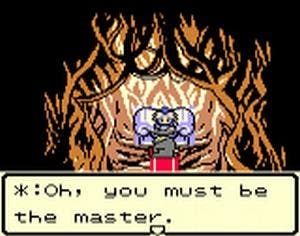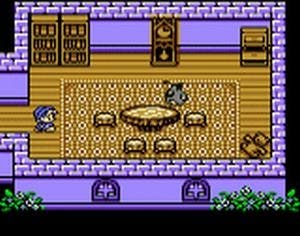Dragon Warrior Monsters retrospective
A brief history of slime.
I've been playing Dragon Warrior Monsters for 15 years, and I've never beaten it. It's travelled with me across the UK, across Europe, across the world. In its own weird way, it's always had its hooks in me deeper than any other game. We've got history.
It was released in 1999 for the Game Boy Color, a spin-off from a JRPG series that had never made it to our shores before. It was an obvious attempt by Enix (now Square Enix) to capitalise on the explosive Pokemon craze, following a suspiciously familiar formula; a young boy captures monsters, trains them to fight, and uses them to compete in a series of escalating tournaments. The thing is... it's better. It has scope and ambition that Pokemon argurably couldn't match.
What sets Dragon Warrior Monsters apart is its bizarre and wonderful breeding system. You don't just build a team in this game, you build bloodlines, great twisted genealogies whose power grows with each generation.

Any two monsters, captured in the wild, can be bred with each other (assuming one is male and the other female). While they will leave your world forever once the mating is done, their single child will take on the strengths and abilities of both, and be more powerful than either could have ever been. Of course, any children of that child will be even stronger, meaning that throughout the game, successive generations must constantly be created in order to succeed.
As you would expect, any offspring also take on an appearance and nature derived from a combination of its two sires. This is where it starts to get weird. The creatures of Dragon Warrior Monsters are not the fuzzy woodland animals of Pokemon. They're genuinely monstrous, creations born of horror and folklore skewed through a distinctly Japanese lens. Shambling zombies, cruel-eyed dragons, colossal golems, cackling demons, living swords, dancing chickens, yetis, and kangaroos holding skulls. They're ugly, strange and authentically otherworldly.
There is a great wonder in seeing the outcomes of the combinations, and they stay true to a child's logic. Breed a Healer (part of the 'Slime' family, which consists entirely of creepy-faced smiling blobs) with an EvilPot (a sentient and malicious cooking pot) and you get a BoxSlime, a blob in the shape of a box. Of course you do. From the Healer, it takes its gooey consistency, and from the EvilPot, it takes the shape of a mundane object. It's a delightful system, and one that fits into an undeveloped vision of the world. Why question the physical realities of a jellyfish having intimate relations with a piece of kitchenware; in this world, it just makes sense.
Once you get past the strangeness, however, you find what the system is really about. The game is confronting you with a huge and hostile world, and giving you the tools to tame it, on your own terms. Monsters attack you, so you capture them and use them to make better monsters.

You might assume that the constant switching out of monsters would lead you to be less invested in them. In fact, the opposite is true. You're that much more invested, because for each monster, you knew their father and mother, and their grandparents, and their great-grandparents, right back to the first humble creatures you started with. Entire lineages at your beck and call, shaped to your will from the soft clay of random encounters.
There are monsters in my game right now whose ancestry spans years of real time. Their stats and abilities are a map of my own life: the long aeroplane flight that saw the rise of a proud line of trumpet-beasts; the power-cut during which the Bugs learned their elemental magicks; the dull family reunion that spawned three generations of zombified dragons. Snapshots in time, all preserved on a little grey cartridge.
These carefully cultivated minions would be meaningless without a world to conquer, and Dragon Warrior Monsters provides. A sprawling city, carved out of the trunk of a colossal tree, acts as central hub, and from it one is able to enter portals to the wildernesses. Each area is randomly generated, and often maze-like in layout. Hidden somewhere will be another portal, leading to another wilderness, and so on, until a final boss is reached. As the game goes on, the amount of portals that must be passed through to reach the end increases, and the areas expand.

The steady up-scaling and the random generation combine to make the world seem more than huge. It's infinite, and as the journeys naturally become longer and more convoluted, they feel more and more like great expeditions into the unknown. A map that automatically fills in as you explore, and a number that ticks down how many portals are left to go, allow you to retain the sense of taming the space, turning it to your will, as with the monsters.
With each milestone reached, the hub city grows, changing and spreading over time like a colossal tree. New places open up, and existing ones change; little NPC events peppered around tell you that you aren't the only one to notice the passage of time. It's a place that always feels like home, but never quite familiar.
All of this is why, in 15 years, I've never beaten it. It's not because of the endless grinding required, or the failings of the deliberately awkward save system, or my own cack-handedness at video games. It's because its systems and world have always fascinated me so much more than its through-line. They shouldn't be made finite. They should live on, without end, on that little grey square.
It has affected how I think about video games to this day. A story can be told in almost any medium, but what makes games unique is the way in which they can engage you, draw you in to something that feels at once much larger and much smaller than yourself.
I don't travel as much as I used to, don't get as many aimless, lazy stretches of time. Perhaps now my Game Boy is turned on only once a year, or once in two, but when it is, it's always the same. I'm taken right back to being ten years old, to jumping through portals and exploring alongside monsters that, now, are near-forgotten great-grandfathers.
